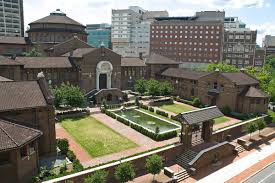In honor of the first visit by Pope Francis and the World Meeting of Families in Philadelphia, the Penn Museum offers a special focus on the ancient Near East, Egypt, and the Bible Lands—with a limited-time-only display of rare artifacts from the collections of the University of Pennsylvania, on view August 15 through November 8, 2015.
A centerpiece exhibition, Sacred Writings: Extraordinary Texts of the Biblical World, highlights the many ways the Bible—and stories akin to those in the Bible—have been represented over time and across continents.
Treasures from the Penn Museum:
- One of the world’s oldest fragments of the gospel of Saint Matthew, written on papyrus and dating to the 3rd century CE, was once part of a codex (book). This fragment, written in ancient Greek, contains the beginning of the Gospel of Matthew (Ch 1. Verses 1-9, 12, 14-20), which begins with the lineage of Jesus, then describes how Mary became with child by the Holy Spirit.
- An ancient clay tablet in Sumerian cuneiform from the site of Nippur in Mesopotamia (now in Iraq), ca. 1650 BCE, contains the earliest version of the Mesopotamian flood story. A version of this tale becomes incorporated into the Epic of Gilgamesh, and tells of a flood that destroyed humankind; the story closely parallels the biblical story of Noah.
- Two folios from a richly decorated, illuminated Qur’an from Iran, copied and signed by its scribe in Hamadan in 1164. The copy is written with black ink in cursive Naskh Arabic script, and features the complete text of the Qur’an, with commentary in red script. The exhibited pages feature the Surah Nuh (Noah), with a mention of the Flood and Noah’s role as admonisher.
Treasures from the Penn Libraries’ Collections:
- An illuminated Latin Bible produced in Arras, France in the late 13th century.
- The first authorized Roman Catholic translation of the New Testament Bible into English, printed at Reims, France, through the efforts of English Catholic exiles, in 1582.
- The first complete Bible printed in the New World, a monumental translation of the Bible into the Native American Massachusett language, by Puritan missionary John Eliot, in 1663.
- A polyglot New Testament Bible compiled by German scholar Elias Hutter with side by side text in twelve languages—Syriac, Hebrew, Greek, Latin, German, Czech, Italian, Spanish, French, English, Danish, and Polish—printed in Nuremberg in 1599.
- A late 15th century Italian illustrated manuscript copy of Werner Rolevinck’s history of the world detailing events from the creation to the election of Pope Sixtus IV.
- An early 16th century Rabbinic Bible from the famed Hebrew printing house of Daniel Bomberg in Venice, Italy.
- A limited edition contemporary Bible from the Pennyroyal Caxton Press, 1999, designed and illustrated by Barry Moser.
You can get more information http://penn.museum/current-changing-exhibits/sacred-writings.html?utm_source=homepage&utm_medium=slider&utm_term=1&utm_content=&utm_campaign=home


